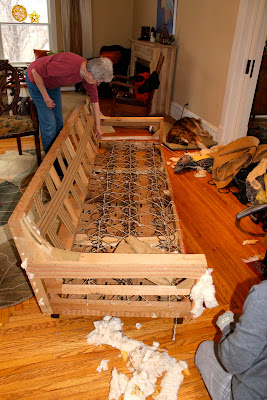We got freezing drizzle yesterday afternoon, so I essentially skated through chores and gave the slush-covered cows extra hay for supper and extra straw for bedding. It rained all evening with the temperature hovering at freezing. When I let the dogs out before bed (or tried to, they refused to go out) I was dazzled by an ice-encrusted world!
Limbs that are normally way above where I can reach were bowing down to my shoulders, encased in ice. It was very windy and the branches were shaking and clattering like maracas. It was impossible to capture the beauty of the night with my camera - for one thing I was kind of afraid to go out under the trees, worried a heavy branch would crash down onto me. I snapped this photo from the steps, lit by the yard light, branches waving furiously.
This one was taken with the flash.
I was hoping to capture the beauty this morning but most of the ice had already melted from the trees. It is still raining steadily, gray and dreary. We have some clean-up to do.
This branch is too heavy for me to move alone and the electric fence is now compromised. At least I don't think the cows will attempt leaping over the fence when it is so icy. They have been stepping very carefully across the treacherous pasture.
Electric fence with icy barbs.
Jitterbug and a rooster sharing a bit of grain in the rain.
The dogs are dismayed and the yard and driveway are a slushy, muddy mess. So much for the beauty of the ice storm. If the sun does break through the gloom later on, I will try to capture some sparkle.
Limbs that are normally way above where I can reach were bowing down to my shoulders, encased in ice. It was very windy and the branches were shaking and clattering like maracas. It was impossible to capture the beauty of the night with my camera - for one thing I was kind of afraid to go out under the trees, worried a heavy branch would crash down onto me. I snapped this photo from the steps, lit by the yard light, branches waving furiously.
This one was taken with the flash.
I was hoping to capture the beauty this morning but most of the ice had already melted from the trees. It is still raining steadily, gray and dreary. We have some clean-up to do.
This branch is too heavy for me to move alone and the electric fence is now compromised. At least I don't think the cows will attempt leaping over the fence when it is so icy. They have been stepping very carefully across the treacherous pasture.
Electric fence with icy barbs.
Jitterbug and a rooster sharing a bit of grain in the rain.
The dogs are dismayed and the yard and driveway are a slushy, muddy mess. So much for the beauty of the ice storm. If the sun does break through the gloom later on, I will try to capture some sparkle.


















































